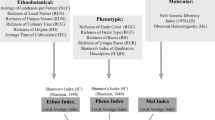Abstract
Knowledge about maize varieties is the key to rural households' survival in native Mexico. Native peoples relate to nature in particular ways and they play a crucial role in maintaining biodiversity. This paper discusses the relationship between native women's accumulated knowledge on maize varieties and the laboratory analysis of the species that they manage. Fieldwork was conducted in an Otomí community, San Pablo Arriba, located in the state of Mexico.
Similar content being viewed by others
References
Alvarez Santiago, H. (1994). “El Tlalocan: símbolos y relaciones socioambientales ente los Nahuas.” Antropología 1(2): 20-30.
Barkin, D. and B. Suárez (1985). El fin de la autosuficiencia alimentaria. Mexico: Ediciones Océano and Centro de Ecodesarollo.
Bedolla, S. and L. W. Rooney (1982). “Kocking maize for masa production.” Cereal Foods World 27: 219-221.
Buendia González, M. O. (1981). Caracteristicas morfológicas de mazorca, propiedades fisicas y de calidad protéica de maíz (Zea mays L.) normal y mejorado, relacionado con el proceso de nixtamalización. BA Thesis, Universidad Autónoma Chapingo, Mexico.
Campillo, F. (1995). “Mujer y trabajo en el medio rural.” Paper presented at the Workshop on Women and Work in Latin America. Universidad de Buenos Aires, 27–28 April.
Carrión, L. (1984). “Modernización agraria y cambios en el rol de la mujer,” in C. Spindel, J. Jaquette, and M. Cardini (eds.), A mulher rural e mudancas no processo de producao agricola: estudios sobre América Latina. Brasilia: HCA.
Cebotarev, E. (1994). Mujer, familia y desarrollo. Manizales, Colombia: Universidad de Caldas, Facultad de Desarrollo Familiar.
Chiappe, M. (1994). “Mujer y agricultura sustentable en América Latina: posibilidades y desafíos para la investigación.” Paper presented at the IV Latin American Conference of Rural Sociology. 7–9 December. Concepción, Chile.
Deere, C. D. (1982). “La mujer rural y la producción de subsistencia en la periferia capitalista,” in M. León (ed.), Las trabajadoras del campo. Vol. II. Bogotá (pp. 11-12). Colombia: ACEP (Asociación Colombiana para el Estudio de la Población).
Escobar, A. (1996). “Planificación,” in W. Sachs (ed.), Diccionario del desarrollo, una guía del conocimiento como poder. Lima, Perú: PRATEC, CAM (Centros de Aprendizaje Mútuo).
FAO (1985). Women in Development Agriculture Rome. Human Resources Institutions and Agrarian Reform.
Ferguson, A. E. (1994). “Gendered science: A critique of agricultural development.” American Anthropologist (96): 540-552.
Galinier, J. (1990). La mitad del mundo. Cuerpo y cosmos en los rituales otomies. Mexico: UNAM, INI.
Gómez Eras, J. (1993). Métodos comparativos para determinar dureza en maíz y su influencia en el tiempo de nixtamalización. BA Thesis, Universidad Autónoma Chapingo, Mexico.
Health Census, San Pedro Arriba, Municipality of Temoaya (1996). State of Mexico.
Kusch, R. (1962). América profunda. Argentina. Editorial Hachette.
La Jornada (1998). “En México, 3.9 millones de mujeres encabezan un hogar.” July 11, p. 47.
Muñoz, A. (1993). “Diversidad genética de maíces criollos en el Valle de Puebla,” in Memorias I Simposio Internacional y II Reunión Nacional sobre Agricultura Sostenible. México: Comisión de Estudios Ambientales y CEICADAR (Centro de Enseñanza, Investigación y Capacitación para el Desarrollo Agrícola Regional), Puebla del Colegio de Postgraduados.
Robles de la T., R. (1986). Cambios fisioquímicos del almidón durante la nixtamalización del maíz. BA Thesis. Instituto Nacional Politécnico, México.
Salinas, M. and V. Arellano (1989). “Calidad nixtamalera y tortillera de hibridos de maíz con diferente tipo de endospermo” (Sociedad Mexicana de Fitotecnia AC), Revista Fitotecnia Mexicana 12(2): 129.
Vázquez García, V. (1996). “Mujeres que respetan su casa: género, economia doméstica y estatus marital de las mujeres en una comunidad nahua del Sur de Veracruz,” in S. González Montes and J. Tuñón Pablos (eds.), Mujeres y familia en México. Mexico: Colegio de México.
Author information
Authors and Affiliations
Rights and permissions
About this article
Cite this article
Cabrera, I.R., Martelo, E.Z. & García, V.V. Gender, rural households, and biodiversity in native Mexico. Agriculture and Human Values 18, 85–93 (2001). https://doi.org/10.1023/A:1007669132011
Issue Date:
DOI: https://doi.org/10.1023/A:1007669132011




